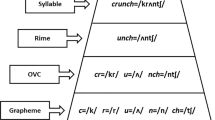Abstract
The present study used two word-naming experiments to investigate whether a phonological representation is computed in the perception of multisyllabic words. In the first experiment, 100- or 250-msec beginning syllable previews were given, followed by the whole word. The results indicated that no phonological representation was computed at 100 msec, but a phonological representation was computed at 250 msec. In Experiment 2, the second syllable was given as a prime for either 100 or 250 msec. The results showed that no phonological representation was computed for the end of a multisyllabic word. Results are discussed in terms of current dual-route theory and connectionist models.
Similar content being viewed by others
References
Carr, T. H., & Pollatsek, S. (1985). Recognizing printed words: A look at current models. In D. Besner, T. G. Waller, and E. M. Mackinnon (Eds.),Reading research: Advances in theory and practice (Vol. 5, pp. 170–195). Toronto, Ontario, Canada: Academic Press.
Coltheart, M. (1978). Lexicalaccess in simple reading tasks. In G. Underwood (Ed.),Strategies of information processing. New York: Academic Press.
Glushko, R. J. (1979). The organization and activation of orthographic knowledge in reading aloud.Journal of Experimental Psychology: Human Perception and Performance, 5, 674–691.
Humphreys, G. W., & Evett, L. J. (1985). Are there independent lexical and non-lexical routes in word processing?The Behavioral and Brain Sciences, 8, 689–740.
Humphreys, G. W., Evett, L. J., & Quilan, P. T. (1990). Orthographic processing in visual word identification.Cognitive Psychology, 22, 517–560.
Inhoff, A. W., & Tousman, S. (1990). Lexical integration across saccades in reading.Psychological Research, 52, 330–337.
Jared, D., & Seidenberg, M. S. (1990). Naming multisyllabic words.Journal of Experimental Psychology: Human Perception and Performance 16, 92–105.
Kay, J., & Marcel, A. J. (1981). One process not two in reading aloud: Lexical analogies do the work of nonlexical rules.Quarterly Journal of Experimental Psychology, 33a, 397–414.
Kucera, H., & Francis, W. N. (1967):Computational analysis of present day American english. Providence, RI: Brown University Press.
Morris, W. (Ed.). (1981).American heritage dictionary of the english language. Boston: Houghton-Mifflin.
Seidenberg, M. S., & McClelland, J. L. (1989). A distributed developmental model of word recognition and naming.Psychological Review, 96, 523–568.
Seidenberg, M. S., Waters, G. S., Barnes, M. A., & Tannehaus, M. K. (1984). When does irregular spelling or pronunciation influence word recognition?Journal of Verbal Learning and Verbal Behavior, 23, 383–404.
Taft, M., & Forster, K. I. (1976). Lexical storage and retrieval of polymorphemic and polysyllabic words.Journal of Verbal Learning and Verbal Behavior, 15, 607–620.
Author information
Authors and Affiliations
Additional information
This research was supported by a National Science Foundation grant BNS90110067. We thank Kim Clements, Cindy Connine, Fred Smith, Steve Straight, Sheldon Li, Steve Specht, Greg Boheimer, Deb Briihl, Rich Topoloski, Anna Chomiak and Chris Bruun for their support.
Rights and permissions
About this article
Cite this article
Tousman, S., Inhoff, A. Phonology in multisyllabic word recognition. J Psycholinguist Res 21, 525–544 (1992). https://doi.org/10.1007/BF01067529
Issue Date:
DOI: https://doi.org/10.1007/BF01067529




